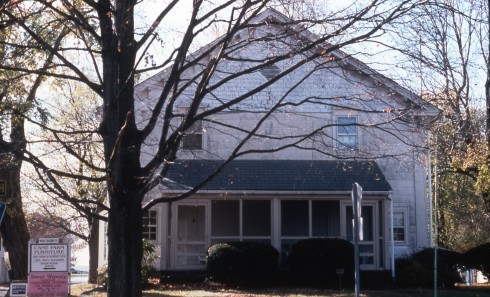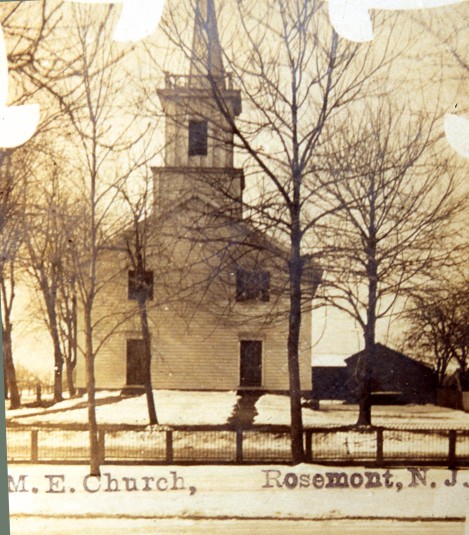I got a letter today from Joan Verity of Frenchtown who wondered about the history of the Methodist Church in Rosemont. It was built in 1860, but only lasted about 20 years.
Charles Cane purchased the building in 1948 and renovated it to serve as housing for his employees. Phil Cane still has a news article about the work that was done, and the bell that once hung in the church steeple can now be seen in the Cane Farm parking lot.
As Joan points out in her letter to me, the Sergeantsville M. E. Church was established in 1838, so the Rosemont church might have been an offshoot, established for members who did not want to travel all the way to Sergeantsville.
I know no more than what appears in the article by Snell’s History of Hunterdon County. Here is what he wrote on page 381:
The First Methodist Society at Rosemont was organized in 1859 at the house of Samuel Hartpence by Rev. William M. Burroughs, with the following members: Asher Reading, Samuel W. Reading, Asa Cronce, Lewis Snyder, Wilson H. Snyder, Joseph Reading, Sr., Samuel Hartpence and Charles Green.
I must interrupt here to observe there is a strange lack of women here. I’m sure this church was not meant to be only for men. Did the writer presume that the wives would automatically come along with their husbands? If he did, he was probably right.
The church was built in 1860, of wood, and dedicated November 8th of the same year by Bishop Edmund S. Janes. The present membership is 42; value of property, $2800.
Snell then goes on to list the pastors who had served the church since its beginning. It is noteworthy that Snell said nothing about the church closing. His book was published in 1881, but submissions had to be made well before that. The church may well have been closed when the book was published. Here are two photographs of the church, then and later:

Mrs. Verity is wondering why the church closed, and why after so short a time. Perhaps the original eight households were simply not enough to sustain a church. Does anyone have any information?

Kay Larsen
March 18, 2015 @ 7:42 pm
Some of my Shermans left the Kingwood M.E. Church to go to the Rosemont church, and some who were there transferred back again (including women). So there were apparently more than those original households involved in the church. I would suggest that the first “organizational meeting” was just that, purely to organize and get a slate of candidates to fill positions on the board—trustees, stewards and such. And, in all likelihood, the women had no input there since none of them would be in leadership positions. Hence the men only bit. I am now searching high and low through my records because I did contact Drew University some years ago and did receive a couple of pages of records from them. They told me that the records they had were very scant and were probably no longer extant. And NOW I cannot even find those.
Kay Larsen
March 18, 2015 @ 8:13 pm
I just found a newspaper announcement of the death of my Great-Uncle Jackson B. Sherman, who died in Jan. of 1902. His funeral service was held in the Rosemont M.E. Church, though the pastor of the Lambertville Methodist Church was the officiant. Jackson was a resident of Lambertville at the time and that is probably why that pastor led the service. So as late as 1902, the church was still used at least on occasion. The reason I wanted to find the records that I had is because I seem to remember that my Great-grandfather’s children by his second marriage, who were all born in the early to mid 1890’s, were mentioned in those records which makes me wonder if the church closed as early as you believe.
Joyce Kintzel
March 20, 2015 @ 11:16 am
My parents and I moved into the apartment on the left, facing the church, in, I think 1948. My dad worked for Charlie Cane. It was 3 bedrooms, 1 bath, huge living room, dining room and eat in kitchen. Same size apartment on the right. The back of the house contained 2 rooms up, 1 room plus kitchen on the 1st floor. Charlie’s cook/housekeeper lived on the 1st floor, 2 male employees in the upstairs rooms. Yes all tenants, at that time, were employees and charged extremely low rent. I’m very pleased to see the picture as it was originally. First time I’ve seen it. Thank you.